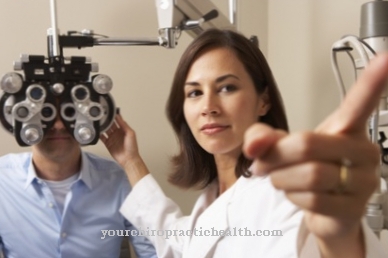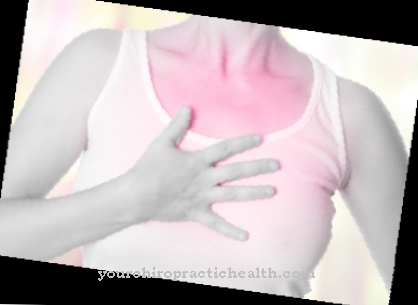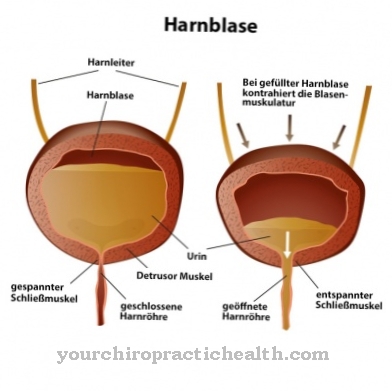Visual disturbances are, as the name itself suggests, disturbances of sight or the eye. The impairment of vision can take many forms. Visual disturbances are often a symptom of an underlying condition. Visual impairments are generally understood to be long-lasting or chronic visual impairments.
What are visual disturbances?

Visual disorders are mostly pathological disorders of the visual apparatus. A visual impairment can have various manifestations. Often tunnel vision, flickering, lightning, bright spots, double images or a restricted field of view occur with visual disturbances. But there are also distorted, obscure and blurry visualizations.
Since visual disturbances often occur as a symptom of an underlying disease, it is also followed by accompanying symptoms, such as headache, vomiting or general weakness. Visual disturbances usually only occur for a short time. In some cases, however, they persist for a long time or even years. If visual disturbances occur regularly, medical help should be sought.
causes
Visual disturbances can have a wide variety of causes. They do not always conceal more serious illnesses. For example, visual disturbances can occur with migraines, circulatory shock and hypoglycaemia.
Other causes of visual disturbances are: inflammation of the optic nerve, arterial occlusion in the retina, bleeding in and around the eye, circulatory disorders in the eye or retinal detachment.
A rather harmless nature are visual disturbances related to nearsightedness or farsightedness. Here the visual disturbances mostly occur for years or forever.
Causes of cataracts, age-related impairment of performance and regression of the cornea are less common.
You can find your medication here
➔ Medicines for visual disturbances and eye complaintsDiseases with this symptom
- Cataract
- myopia
- Farsightedness
- Retinal disease in high blood pressure
- astigmatism
- Brain tumor
- migraine
- Optic nerve inflammation
- Retinal detachment
- Presbyopia
- Age-related macular degeneration
- multiple sclerosis
- Circulatory shock
- Hypoglycemia
- glaucoma
- Uveitis
- Myasthenia gravis pseudoparalytica
- Diabetes mellitus
Diagnosis & course
A diagnosis of visual disturbances usually begins with a detailed description of the patient's symptoms. Important information includes, for example, the time of the first onset of visual disturbances, the possible presence of accompanying symptoms (such as headaches and nausea) or visual field deficits as well as any seeing flashes or double images.
Further diagnostic steps include, among other things, eye tests, eye pressure and visual field measurements as well as ophthalmoscopy. If the diagnosis is suspected, ultrasound and blood tests as well as neurological examinations can follow.
Depending on the cause (s) of the visual disturbances, these can occur suddenly or gradually. While some visual disturbances subside after a short time, other visual impairments may acutely worsen with a time lag.
Complications
Vision problems usually do not need to be treated if the person does not directly want it or is not dissatisfied with the situation. Anyone with a visual impairment should definitely use a visual aid, primarily glasses or contact lenses. Those who do not use visual aids can risk the visual impairment worsening even further.
It is very stressful for the muscles of the eyes when they can only see fuzzy outlines and then have to strain to correct the curvature of the lens. In addition, headaches and dizziness can occur if the eyes are blurred for a long period of time. There are usually no complications when wearing visual aids or contact lenses. Contact lenses must be taken out of the eye at night so that they do not stick together or slip behind the eyeball.
With laser correction, side effects or complications are extremely rare. In most cases, the patient's vision improves immediately after the procedure and the procedure is safe.
When should you go to the doctor?
A doctor should always be consulted in the event of visual disturbances. It is a very unhealthy condition. If a doctor is not consulted in the case of visual disturbances, these will usually worsen further, as the eye muscles are unnecessarily strained. Most of the time, the disturbances do not go away by themselves.
If the patient suffers from visual disturbances over a longer period of time, a doctor must be consulted. This can diagnose poor eyesight or an eye disease. In any case, a visit to the doctor is necessary if the visual disturbances are also associated with eye pain or if the person concerned complains of a foreign body sensation in the eye. This can be an eye disease that needs treatment.
In some cases, visual disturbances can occur temporarily during a migraine. No treatment is necessary if these disappear on their own after a short time. If the problem is only visual impairment, an optician can also be consulted to find appropriate visual aid for the patient. In the event of pain or unusual feelings in the eye, however, a visit to the ophthalmologist is necessary. If an accident has occurred to the eye, an emergency doctor must be called or the hospital must be visited.
Doctors & therapists in your area
Treatment & Therapy
If you have vision problems, you should generally always see a doctor, even if only to have an eye test carried out for glasses. If the visual disturbances occur as part of an underlying disease, the doctor will try to diagnose them through an intensive examination.
The doctor will ask the patient concerned about the extent of the visual impairment. Above all, he will want to know to what extent the impairment of vision occurs (e.g. lightning, dots blurring). In addition, he will also address accompanying symptoms such as nausea, vomiting and headaches.
Of course, an eye test is also part of the doctor's examination. The visual performance as well as the eye pressure and the visual field are measured and determined. An ophthalmoscope may also be necessary to examine the retina more closely for disturbances and abnormalities. Other diagnostic tools are: ultrasound, blood tests and neurological examinations.
Depending on the cause, individual treatment or therapy is carried out. Since a disease is usually responsible for the visual disturbance, it should be treated immediately. Vision problems caused by migraines are usually treated with antiemetics.
If the cause is retinal detachment, surgery will often be necessary. There are now new types of laser processes that promise excellent visual performance. Find out more from your ophthalmologist.
Visual disturbances in the context of harmless farsightedness or nearsightedness can of course be treated with the help of suitable glasses. Modern laser eye surgery can ensure permanent visual improvement. Here, too, your ophthalmologist can give you further, specific information.
Outlook & forecast
In most cases, visual disturbance is an irreversible condition and direct treatment is not possible. Visual disturbances often occur temporarily in people as a result of a migraine. Here it is very likely that the visual disturbances will also go away on their own.
In the case of visual disturbances, the person affected must always wear a visual aid. This includes either glasses or contact lenses. If the visual aid is not worn, the visual disturbances will usually worsen as the muscles of the eyes have to work hard to see clearly. Eye tests should therefore be carried out regularly, especially in children.
Visual disturbances can be removed with a laser, for example. However, this treatment is only carried out in adults, as children’s eyesight can change. If the visual disturbances occur due to a disease or an infection in the eye, a doctor should definitely be consulted. Surgical intervention may also be necessary here.
In most cases, visual disturbances can be corrected or restricted in such a way that the patient can see clearly again by using a visual aid. Everyday life is only slightly restricted and the quality of life is not impaired. Visual disturbances are particularly common in old age and are a common symptom.
You can find your medication here
➔ Medicines for visual disturbances and eye complaintsYou can do that yourself
Short-term vision problems do not necessarily need to be treated by a doctor. Often the blurred or double vision is due to a harmless cause that can be treated independently with the help of a few tricks and home remedies.
If the visual disturbances occur while working on a monitor, it is usually sufficient to take a short break and protect your eyes. A change of environment, physical activity and fresh air give the eyes the opportunity to regenerate and usually lead to an immediate improvement in symptoms. In the case of visual disturbances caused by a foreign body or irritating substances, the eyes should be rinsed out with cool water. Eye drops with the active ingredient of the tamarind have also proven themselves. Fresh blueberries can help with blurred vision, burning sensation or flickering eyes. Visual disturbances in dry and irritated eyes can be dealt with with evening primrose oil from the pharmacy.
If the visual disturbances are accompanied by dizziness and numbness in the limbs, an emergency doctor should be alerted immediately. It may be a heart attack or stroke that requires urgent medical treatment. If possible, first aid measures should be carried out until the rescue service arrives.














.jpg)













